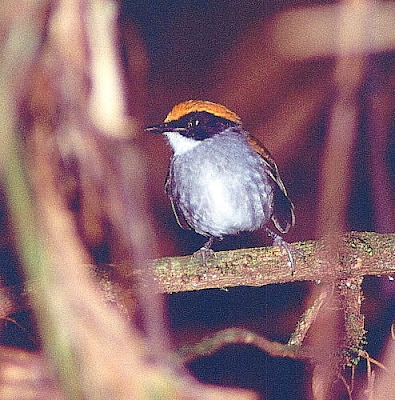My 2nd blog on the trip David and myself made in June and July, 2003. to S.E Brazil. On My previous blog, I rather over stated the number of species seen in Brazil from 3,000 and this should read 1,821 of which 236 are endemic to Brazil.
The grounds at Serra dos Tucanos lodge, we stayed at this lodge
for four nights and explored the area well.
The walking trails near Serra dos Tucanos lodge
. Red-legged Seriemas
Cariama cristata
Red-legged Seriema's can be found in grassland from E. Brazil to Central Argentina. They can weigh up to 1.5Kg and they can grow up to one metre in height. They prefer grassland habitat where they search for prey including reptiles and rodents and if chased they can run up to 25 mph.
We recorded them on five dates with up to 4 on a day, chiefly in the Canastra Nat. Park.
Black-cheeked Gnateater
Conopophaga melanops
This attractive species is endemic to Brazil and its natural habitat is tropical moist lowland forest . Its range also includes the eastern coastal areas of Brazil although sadly this has now been fragmented by the destruction of its habitat.
We obtained excellent views of two along the Circuit Trail at the Serra dos Tocanos Lodge. We would not wish to have missed this on our trip.
Male Festive Coquette
Lophornis chalybeus
This stunning hummingbird has three races and the above race occurs in S.E Brazil. other races occur in other areas of South America. Unfortunately, this specie in recent years is undergoing a moderately rapid decline approaching 30%.
We were fortunate in seeing 5 including several males at Fazendo Capricorno.
Rufous Gnateater
Conopophoga lineata
The Rufous Gnateater is found in forest understorey and bushes, but it can be elusive. It has a range
extending from Eastern Brazil into Eastern Paraguay and North Eastern Argentina.
Butterfly sp.
Torquoise Emperor Butterfly
Female Scissor-tailed Nightjar in Canastran Nat. Park
\Hydropsalis torquata
A lucky find was this female Scissor-tailed Nightjar, to be sitting out in the open on a sandy track in the National Park, and it was the only one we saw. The male has a very long scissor tail. They have a large range from central to eastern South America, and their natural habitats are dry savannah, lowland grassland and forest edges.
Campo Flicker
Colaptes campestris
Campo Flicker has two races and this one has a range from S. Suriname to E. & S. Brazil. It feeds mainly on the ground looking for termite mounds or anthills.










